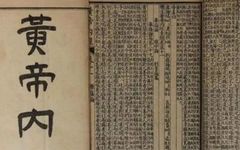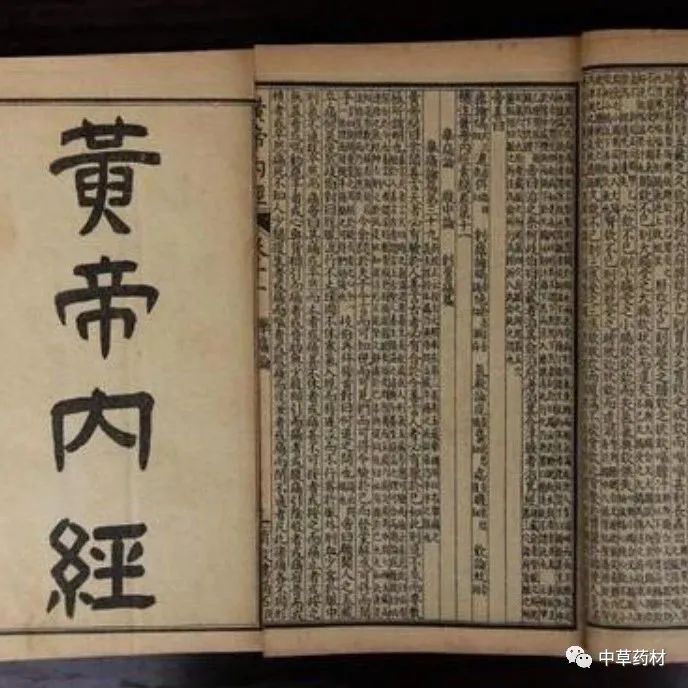
The Huangdi Neijing (Yellow Emperor’s Inner Canon) is an encyclopedic medical work divided into two parts: Ling Shu (Spiritual Pivot) and Su Wen (Plain Questions). It is said to have originated from the legendary Emperor Huangdi and has been passed down orally through generations, later supplemented and developed by physicians and medical theorists, culminating in its compilation during the Spring and Autumn and Warring States periods. It is one of the four classic texts of Traditional Chinese Medicine (TCM) alongside the Nanjing (Classic of Difficult Issues), Shanghan Zabing Lun (Treatise on Cold Damage and Miscellaneous Diseases), and Shennong Bencao Jing (Shennong’s Classic of Materia Medica).
The Huangdi Neijing expounds on TCM theories such as Yin-Yang, Five Elements, Pulse Diagnosis, Zangxiang (Organ Manifestations), Meridians, Etiology, Pathogenesis, Symptoms, Diagnosis, Treatment, Health Preservation, and Five Movements and Six Qi based on the philosophical foundations of Huang-Lao Daoism, presented in a dialogue format between Huangdi, Qibo, and Guizhu. It discusses medicine from a holistic perspective, presenting a systematic medical model that integrates nature, biology, psychology, and society.
The basic materials of the Huangdi Neijing are derived from the ancient Chinese observations of the universe and life phenomena, extensive clinical practice, and knowledge of human anatomy.
The Huangdi Neijing lays the foundation for understanding human physiology, pathology, diagnosis, and treatment, making it a highly influential medical text in China, often referred to as the ancestor of medicine.
Summary
For any issue related to tendons, treat the liver. For any issue related to bones, treat the kidneys. For any issue related to muscles, treat the spleen and stomach. For any issue related to blood vessels, treat the heart. For any skin or hair issues, treat the lungs.
Five Organs
1. Heart: The heart is the residence of the spirit, the master of blood, and the source of pulses. It belongs to the fire element; physiological functions include: ① governing blood vessels; ② governing consciousness; the heart opens to the tongue, connects with the pulse, manifests on the face, corresponds to joy in emotions, and sweat in fluids. The heart is interrelated with the small intestine.2. Lungs: The lungs are the place of the corporeal soul and the master of qi, belonging to the metal element; physiological functions include: ① governing qi and controlling respiration; ② regulating the dispersal and descending of qi; ③ managing the water pathways; ④ governing the hundred vessels and regulating their flow (stagnation); assisting the heart in regulating qi and blood circulation; the lungs connect to the throat, manifest on the skin, correspond to hair, open to the nose, relate to worry in emotions, and produce mucus in fluids. The lungs are interrelated with the large intestine.3. Spleen: The spleen is the source of qi and blood transformation, the foundation of postnatal life, and stores intention, belonging to the earth element. Physiological functions include: ① governing transformation and transportation; ② raising clear qi; ③ controlling blood; it opens to the mouth, connects with the flesh, governs the limbs, manifests on the lips, relates to thought in emotions, and produces saliva in fluids. The spleen is interrelated with the stomach.4. Liver: The liver is the place of the ethereal soul, the storehouse of blood, and the source of tendons, belonging to the wood element, and governs upward movement. Physiological functions include: ① governing the smooth flow of qi; ② storing blood; it opens to the eyes, connects with the tendons, manifests on the nails, relates to anger in emotions, and produces tears in fluids. The liver is interrelated with the gallbladder.5. Kidneys: The kidneys are the root of pre-natal essence, store will, and the waist is the organ of the kidneys, belonging to the water element; physiological functions include: ① storing essence, governing growth, development, and reproduction; ② governing water; ③ controlling the intake of qi; they connect with the bones, govern the marrow, manifest on the hair, open to the ears and the two yin (anus and perineum), relate to fear in emotions, and produce saliva in fluids. The kidneys are interrelated with the bladder.
Six Bowels
1. Gallbladder: Physiological function: stores and excretes bile, the gallbladder governs decision-making. 2. Stomach: Physiological function: receives and digests food, the stomach descends to harmonize. 3. Small Intestine: Physiological function: governs the reception and transformation of substances, separating the clear from the turbid, “the small intestine governs fluids.” 4. Large Intestine: Physiological function: transforms and excretes waste, the large intestine governs fluids. 5. Bladder: Physiological function: stores and excretes urine, relying on the kidney’s qi transformation. 6. Sanjiao: Physiological function: facilitates the flow of original qi, governs the qi mechanism and transformation, serving as the pathway for water and fluids.
Dynamic Diagram of the Fourteen Meridians
In a day, there are twelve time periods, each corresponding to a meridian, connecting end to end like a loop. Mastering your body means mastering the secrets of longevity and health!
1. Gallbladder Meridian
Zi Time: 23:00 – 1:00
Gallbladder Meridian: Deep sleep! The gallbladder needs metabolism; one must sleep during Zi time for the gallbladder to complete its metabolism. At this time, the heart’s function is weakest; if there are heart patients, prepare heart-saving pills.
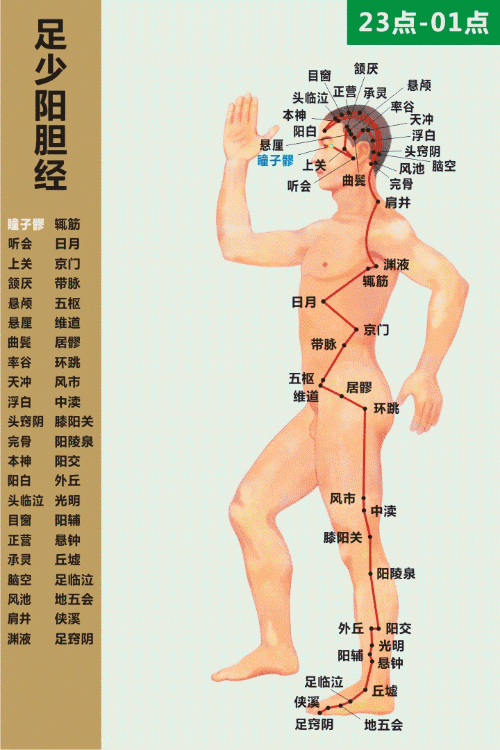 Eliminate diseases, immediate effects; to become a general, one must first have gallbladder courage.Relieve mental and physical worries (anger tends to be stored in the liver; if too much is stored and cannot be released, it blocks the gallbladder, leading to cholecystitis and gallstones. Therefore, we must expel turbid qi; the liver has no direct pathway to the outside world and can only use the gallbladder meridian).Symptoms of Gallbladder Meridian Blockage:1. Problems with the gallbladder usually manifest as bile overflow, resulting in a bitter mouth upon waking, 2. a grayish complexion, 3. frequent migraines, sciatica, or breast issues, 4. gynecological diseases are also governed by the gallbladder meridian, 5. some people experience alternating cold and hot sensations, which is also caused by gallbladder blockage, 6. frequent sighing and pain in the ribs are related to gallbladder stagnation.The Foot Shaoyang Gallbladder Meridian is one of the most important meridians in TCM, starting from the Pupil Therapy Point on the face, winding behind the ear, passing through the neck, chest, abdomen, legs, and ending at the little toe.There are 44 acupoints along this meridian, with many located on the face and lower legs. Blockage of the gallbladder meridian can lead to headaches, migraines, tinnitus, breast diseases, gallstones, varicose veins, etc. My circulation occurs from 23:00 to 1:00; the clearer the bile, the clearer the brain. Sleeping at this time with a clear mind and a rosy complexion, tapping the gallbladder meridian in the morning enhances its effects.If symptoms arise, one can use grapefruit, geranium, or juniper to massage the liver and gallbladder meridian. The liver, stomach, and bladder meridians have already been introduced; more exciting content is coming, so don’t miss it!Acupoints on the Gallbladder Meridian:Shoulder and Neck Point: Treats pain, breast diseases, and lymphatic tuberculosis, Yuan Ye Point: Treats breast hyperplasia, intercostal neuralgia, and armpit sweating.
Eliminate diseases, immediate effects; to become a general, one must first have gallbladder courage.Relieve mental and physical worries (anger tends to be stored in the liver; if too much is stored and cannot be released, it blocks the gallbladder, leading to cholecystitis and gallstones. Therefore, we must expel turbid qi; the liver has no direct pathway to the outside world and can only use the gallbladder meridian).Symptoms of Gallbladder Meridian Blockage:1. Problems with the gallbladder usually manifest as bile overflow, resulting in a bitter mouth upon waking, 2. a grayish complexion, 3. frequent migraines, sciatica, or breast issues, 4. gynecological diseases are also governed by the gallbladder meridian, 5. some people experience alternating cold and hot sensations, which is also caused by gallbladder blockage, 6. frequent sighing and pain in the ribs are related to gallbladder stagnation.The Foot Shaoyang Gallbladder Meridian is one of the most important meridians in TCM, starting from the Pupil Therapy Point on the face, winding behind the ear, passing through the neck, chest, abdomen, legs, and ending at the little toe.There are 44 acupoints along this meridian, with many located on the face and lower legs. Blockage of the gallbladder meridian can lead to headaches, migraines, tinnitus, breast diseases, gallstones, varicose veins, etc. My circulation occurs from 23:00 to 1:00; the clearer the bile, the clearer the brain. Sleeping at this time with a clear mind and a rosy complexion, tapping the gallbladder meridian in the morning enhances its effects.If symptoms arise, one can use grapefruit, geranium, or juniper to massage the liver and gallbladder meridian. The liver, stomach, and bladder meridians have already been introduced; more exciting content is coming, so don’t miss it!Acupoints on the Gallbladder Meridian:Shoulder and Neck Point: Treats pain, breast diseases, and lymphatic tuberculosis, Yuan Ye Point: Treats breast hyperplasia, intercostal neuralgia, and armpit sweating.
2. Liver Meridian
Chou Time: 1:00 – 3:00
Liver Meridian: Deep sleep! This is the best time for liver repair; waste blood needs to be eliminated, and fresh blood needs to be produced during Chou time. One must enter a deep sleep state to provide the liver with sufficient energy. If one does not sleep, the liver continues to output energy to support thinking and actions, preventing metabolism from completing, leading to liver disease.
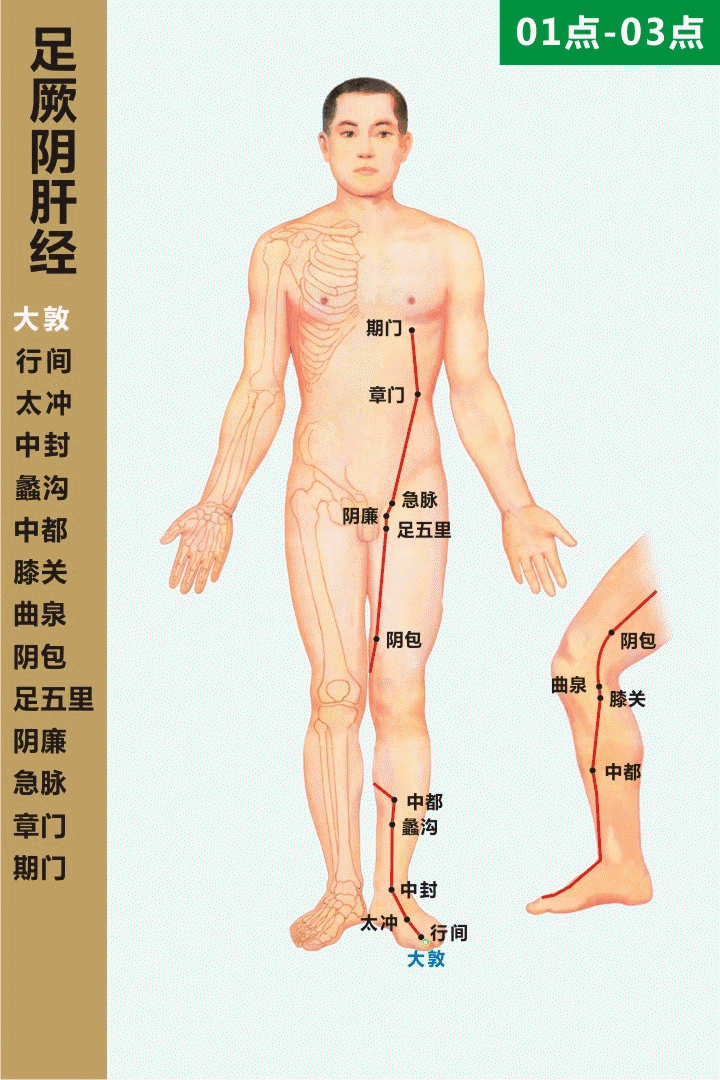 The universal remedy for life (in TCM, all diseases arise from qi; qi originates from the liver, and excessive anger harms the liver, so one should try to be less angry; once anger arises, it cannot be contained). Friends, wake up and quickly tap the liver and gallbladder meridian for health. The Foot Jueyin Liver Meridian is one of the most important meridians in the body, starting from the inner side of the big toe and ending at the Da Dun Point in the chest, traversing the foot, leg, abdomen, and chest. There are 14 acupoints along this meridian; blockage can lead to breast hyperplasia, chronic liver disease, menstrual irregularities, and uterine issues.The circulation time is from 1:00 to 3:00; massaging during this period can enhance the functions of the five organs. Essential oils such as sage, chamomile, rosemary, bergamot, and lavender can enhance the massage effects.If there is pain in the ribs, a bitter mouth, toothache, jaw pain, oral ulcers, or nosebleeds, especially if there are blisters on the tongue, it indicates excessive heart fire. At this time, the fire is no longer in the liver, and one should frequently massage the Heng Jian Point.All diseases arise from the heart; to eliminate heart issues, one must address liver fire and enhance the liver’s detoxification function. Once the liver’s detoxification function is strengthened, the blood will be cleansed, preventing high blood lipids. Many chronic diseases manifest in the liver; only by properly managing this detoxification factory can one avoid illness.If one frequently experiences dizziness, weakness, and insufficient heart blood supply upon examination, it indicates weakened liver function, as the liver provides qi and blood to the heart. Therefore, liver conditioning is necessary.
The universal remedy for life (in TCM, all diseases arise from qi; qi originates from the liver, and excessive anger harms the liver, so one should try to be less angry; once anger arises, it cannot be contained). Friends, wake up and quickly tap the liver and gallbladder meridian for health. The Foot Jueyin Liver Meridian is one of the most important meridians in the body, starting from the inner side of the big toe and ending at the Da Dun Point in the chest, traversing the foot, leg, abdomen, and chest. There are 14 acupoints along this meridian; blockage can lead to breast hyperplasia, chronic liver disease, menstrual irregularities, and uterine issues.The circulation time is from 1:00 to 3:00; massaging during this period can enhance the functions of the five organs. Essential oils such as sage, chamomile, rosemary, bergamot, and lavender can enhance the massage effects.If there is pain in the ribs, a bitter mouth, toothache, jaw pain, oral ulcers, or nosebleeds, especially if there are blisters on the tongue, it indicates excessive heart fire. At this time, the fire is no longer in the liver, and one should frequently massage the Heng Jian Point.All diseases arise from the heart; to eliminate heart issues, one must address liver fire and enhance the liver’s detoxification function. Once the liver’s detoxification function is strengthened, the blood will be cleansed, preventing high blood lipids. Many chronic diseases manifest in the liver; only by properly managing this detoxification factory can one avoid illness.If one frequently experiences dizziness, weakness, and insufficient heart blood supply upon examination, it indicates weakened liver function, as the liver provides qi and blood to the heart. Therefore, liver conditioning is necessary.
3. Lung Meridian
Yin Time: 3:00 – 5:00
Lung Meridian: The transformation of yin and yang begins at this moment, transitioning from yin to yang. The body enters a phase of yang flourishing and yin declining. At this time, the lung meridian is most active. The liver supplies blood to the lungs, which then distributes it throughout the body. The body requires a large amount of oxygen at this moment. Patients with lung diseases or asthma should take medication during Yin time for better effects than during the day.
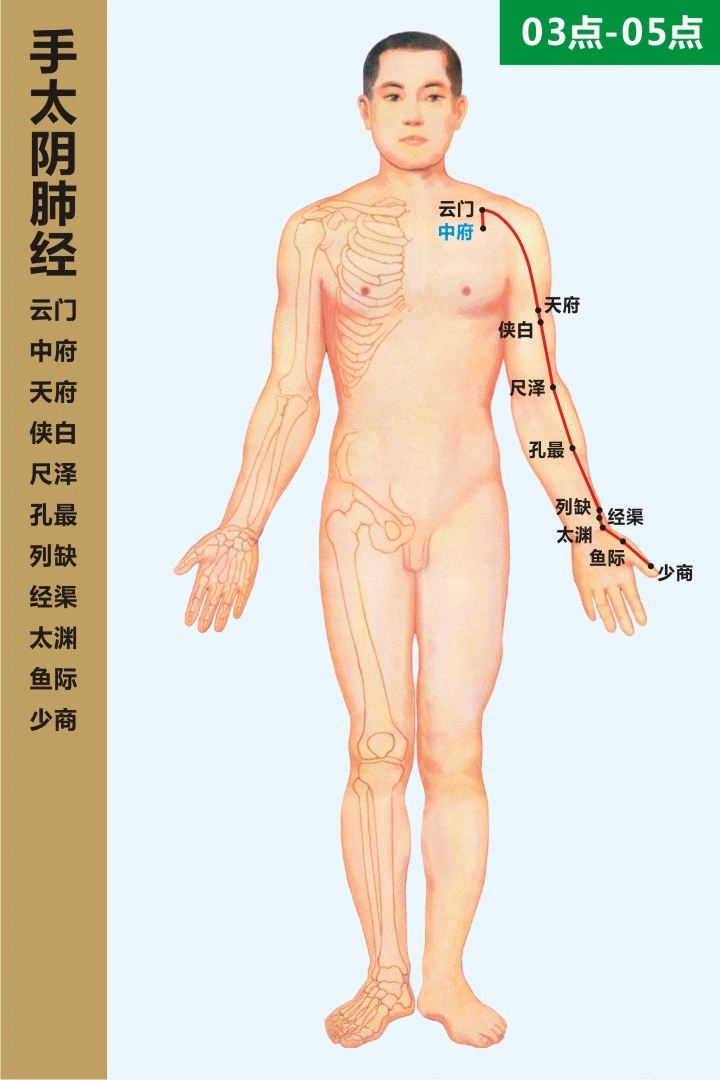 The lung meridian can treat lung-related issues; the lungs open to the nose, so nasal issues are often related to the lung meridian, as well as throat issues, so throat problems can be resolved through the lung meridian. The primary goal of unblocking the meridians is to expel turbid qi; many people experience burping when massaging the lung meridian, which is a very good phenomenon.Acupoints on the Lung Meridian:Shao Shang Point: Treats acute throat swelling and pain.Yu Ji Point: The fire point of the lung meridian, effective for clearing heat.Tai Yuan Point: When lung qi is sufficient, one feels energetic; this point is specifically for tonifying qi; frequent massage can provide endless energy.
The lung meridian can treat lung-related issues; the lungs open to the nose, so nasal issues are often related to the lung meridian, as well as throat issues, so throat problems can be resolved through the lung meridian. The primary goal of unblocking the meridians is to expel turbid qi; many people experience burping when massaging the lung meridian, which is a very good phenomenon.Acupoints on the Lung Meridian:Shao Shang Point: Treats acute throat swelling and pain.Yu Ji Point: The fire point of the lung meridian, effective for clearing heat.Tai Yuan Point: When lung qi is sufficient, one feels energetic; this point is specifically for tonifying qi; frequent massage can provide endless energy.
4. Large Intestine Meridian
Mao Time: 5:00 – 7:00
Large Intestine Meridian: Time for bowel movement! Drink a cup of warm water before defecation. This is the time when the large intestine is most active, absorbing moisture and nutrients from food and excreting waste.
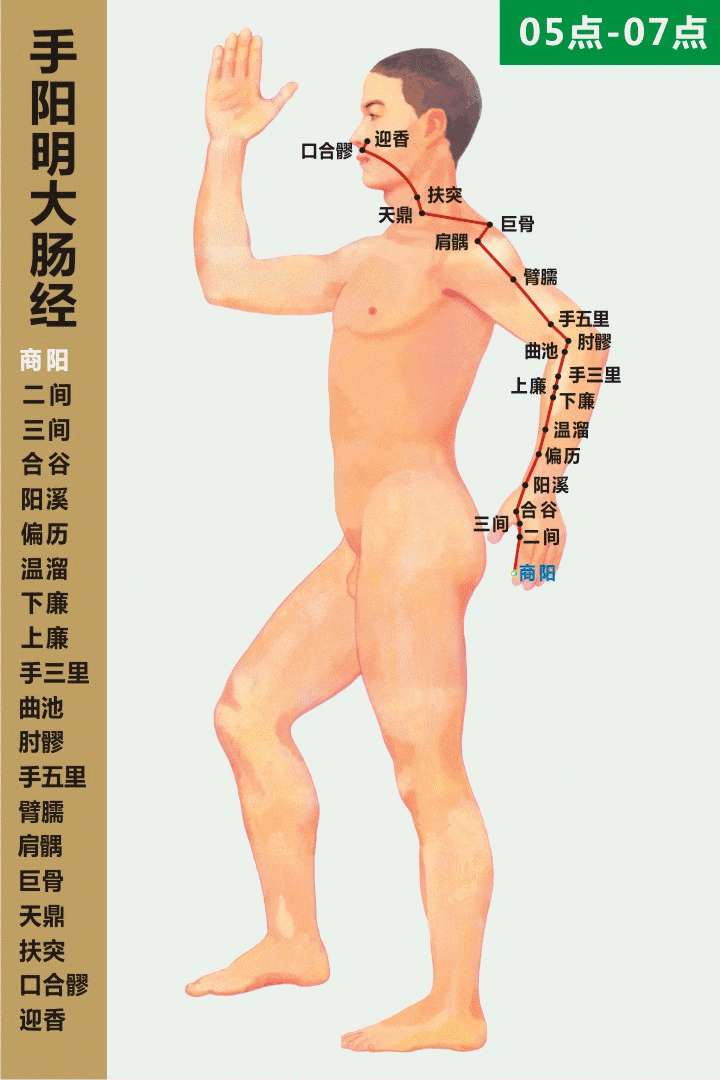 The skin and lungs’ protector, the Hand Yangming Large Intestine Meridian is the best meridian for treating constipation and diarrhea, starting from the Shang Yang Point on the index finger and ending at the Ying Xiang Point on the face, traversing the hand, arm, neck, and face. There are 20 acupoints along this meridian.Blockage of the large intestine meridian can lead to constipation, diarrhea, gastrointestinal issues, dry and swollen eyes, etc. The circulation time is from 5:00 to 7:00; if one does not defecate during this time, it indicates blockage of the large intestine meridian. Essential oils such as geranium, grapefruit, sweet orange, and lemon can be used for massage to achieve therapeutic and maintenance effects.Acupoints on the Large Intestine Meridian:Ying Xiang Point: Treats rhinitis.
The skin and lungs’ protector, the Hand Yangming Large Intestine Meridian is the best meridian for treating constipation and diarrhea, starting from the Shang Yang Point on the index finger and ending at the Ying Xiang Point on the face, traversing the hand, arm, neck, and face. There are 20 acupoints along this meridian.Blockage of the large intestine meridian can lead to constipation, diarrhea, gastrointestinal issues, dry and swollen eyes, etc. The circulation time is from 5:00 to 7:00; if one does not defecate during this time, it indicates blockage of the large intestine meridian. Essential oils such as geranium, grapefruit, sweet orange, and lemon can be used for massage to achieve therapeutic and maintenance effects.Acupoints on the Large Intestine Meridian:Ying Xiang Point: Treats rhinitis.
5. Stomach Meridian
Chen Time: 7:00 – 9:00
Stomach Meridian: Don’t forget breakfast! At this time, gastric acid is continuously secreted; if one goes too long without eating, it can lead to gastric ulcers, gastritis, duodenitis, and cholecystitis.
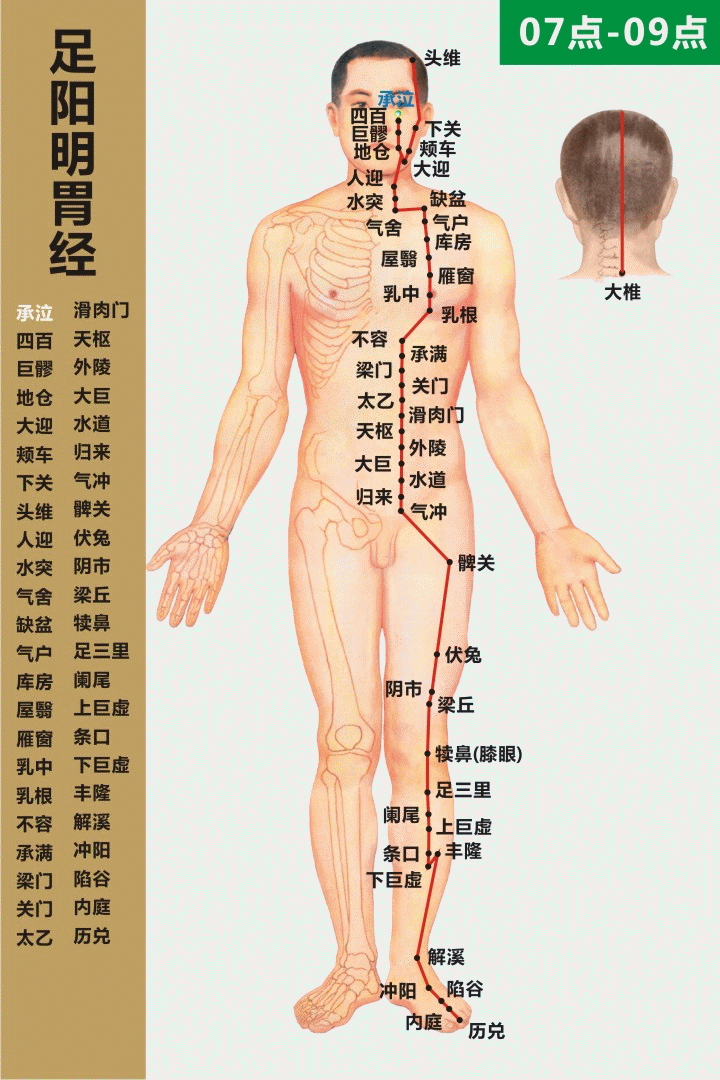 Every day nurtures our postnatal foundation. A smooth stomach meridian leads to good sleep, appetite, and a rosy complexion, and can even rejuvenate one’s youth. The stomach meridian manages gastrointestinal function; once gastrointestinal function is disrupted, the entire body becomes weak.The sun shines brightly, and the Foot Yangming Stomach Meridian starts from the Cheng Qi Point on the face and ends at the Li Dui Point on the foot, traversing the face, neck, chest, abdomen, and legs. There are 43 acupoints along this meridian, with the most located in the abdomen and chest. Blockage of the stomach meridian can cause discomfort throughout the entire meridian. The stomach meridian circulates from 7:00 to 9:00, so we must eat breakfast during this time. If you already have symptoms of stomach meridian blockage, you can use sweet orange, lemon, bergamot, geranium, and sandalwood essential oils for massage.Acupoints on the Stomach Meridian:Cheng Qi: Can quickly relieve tearing when facing the wind and treat glaucoma.Si Bai: If dark circles, eye swelling, and soreness occur, persistent massage can resolve many issues.Jia Che: Treats facial nerve paralysis, teeth grinding at night, and jaw clenching; massaging this point is very effective.Small Tip: Walking back and forth on a soft bed can help qi and blood flow to the knees, acting like lubrication for the knees, treating common ailments in the elderly such as knee pain, leg weakness, and hypertension. For young people, this is a common method for slimming legs.
Every day nurtures our postnatal foundation. A smooth stomach meridian leads to good sleep, appetite, and a rosy complexion, and can even rejuvenate one’s youth. The stomach meridian manages gastrointestinal function; once gastrointestinal function is disrupted, the entire body becomes weak.The sun shines brightly, and the Foot Yangming Stomach Meridian starts from the Cheng Qi Point on the face and ends at the Li Dui Point on the foot, traversing the face, neck, chest, abdomen, and legs. There are 43 acupoints along this meridian, with the most located in the abdomen and chest. Blockage of the stomach meridian can cause discomfort throughout the entire meridian. The stomach meridian circulates from 7:00 to 9:00, so we must eat breakfast during this time. If you already have symptoms of stomach meridian blockage, you can use sweet orange, lemon, bergamot, geranium, and sandalwood essential oils for massage.Acupoints on the Stomach Meridian:Cheng Qi: Can quickly relieve tearing when facing the wind and treat glaucoma.Si Bai: If dark circles, eye swelling, and soreness occur, persistent massage can resolve many issues.Jia Che: Treats facial nerve paralysis, teeth grinding at night, and jaw clenching; massaging this point is very effective.Small Tip: Walking back and forth on a soft bed can help qi and blood flow to the knees, acting like lubrication for the knees, treating common ailments in the elderly such as knee pain, leg weakness, and hypertension. For young people, this is a common method for slimming legs.
6. Spleen Meridian
Si Time: 9:00 – 11:00
Spleen Meridian: Drink water! (Drink more water at this time) The spleen is the overall coordinator of digestion, absorption, and excretion. The spleen is the foundation of postnatal life. To tonify the spleen: use coix, red beans, and yam porridge. Aim to drink about 2000ml of water (approximately 5 bottles of mineral water) throughout the day; keep drinking and avoid any beverages.
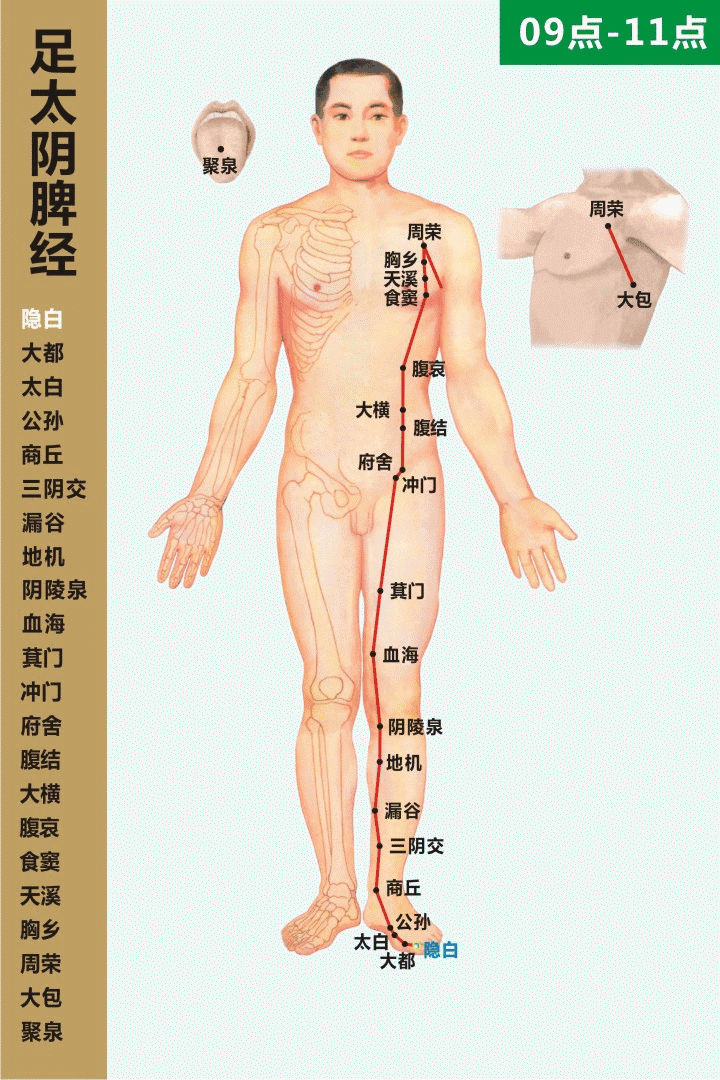 Eliminate any chronic diseases; the foundation of postnatal life and the source of qi and blood transformation. The early bird catches the worm; by waking up early, you can receive health knowledge.The Foot Taiyin Spleen Meridian starts from the Yin Bai Point on the big toe and ends at the Da Bao Point above the chest, traversing from the foot to the leg, abdomen, and stopping at the chest.There are 20 acupoints along this meridian; blockage can lead to muscle relaxation, breast hyperplasia, indigestion, menstrual irregularities, rheumatism, etc. In TCM, the spleen meridian plays a very powerful role, known as the foundation of postnatal life and the source of qi and blood transformation. The circulation time of the spleen meridian is from 9:00 to 11:00; massaging during this time can rapidly enhance the body’s qi and blood. Essential oils such as ginger, sweet orange, lemon, and fennel can help prevent and treat diseases.Regularly massaging the spleen meridian can enhance the body’s qi and blood circulation, providing the greatest capacity for disease prevention and treatment. Massaging the spleen meridian on the calves can help the overweight lose weight and the underweight gain weight. For canker sores on the tongue, massaging the Shaohai Point on the heart meridian can eliminate them; for canker sores on the lips, massaging the acupoints on the spleen meridian on the calves can resolve them.
Eliminate any chronic diseases; the foundation of postnatal life and the source of qi and blood transformation. The early bird catches the worm; by waking up early, you can receive health knowledge.The Foot Taiyin Spleen Meridian starts from the Yin Bai Point on the big toe and ends at the Da Bao Point above the chest, traversing from the foot to the leg, abdomen, and stopping at the chest.There are 20 acupoints along this meridian; blockage can lead to muscle relaxation, breast hyperplasia, indigestion, menstrual irregularities, rheumatism, etc. In TCM, the spleen meridian plays a very powerful role, known as the foundation of postnatal life and the source of qi and blood transformation. The circulation time of the spleen meridian is from 9:00 to 11:00; massaging during this time can rapidly enhance the body’s qi and blood. Essential oils such as ginger, sweet orange, lemon, and fennel can help prevent and treat diseases.Regularly massaging the spleen meridian can enhance the body’s qi and blood circulation, providing the greatest capacity for disease prevention and treatment. Massaging the spleen meridian on the calves can help the overweight lose weight and the underweight gain weight. For canker sores on the tongue, massaging the Shaohai Point on the heart meridian can eliminate them; for canker sores on the lips, massaging the acupoints on the spleen meridian on the calves can resolve them.
7. Heart Meridian
Wu Time: 11:00 – 13:00
Heart Meridian: Take a short nap. The heart drives blood circulation, nourishing the spirit, qi, and tendons. A brief nap can greatly benefit heart health, providing energy for the afternoon and evening. Naps should not exceed 30 minutes, as they can disrupt sleep and lead to insomnia at night.
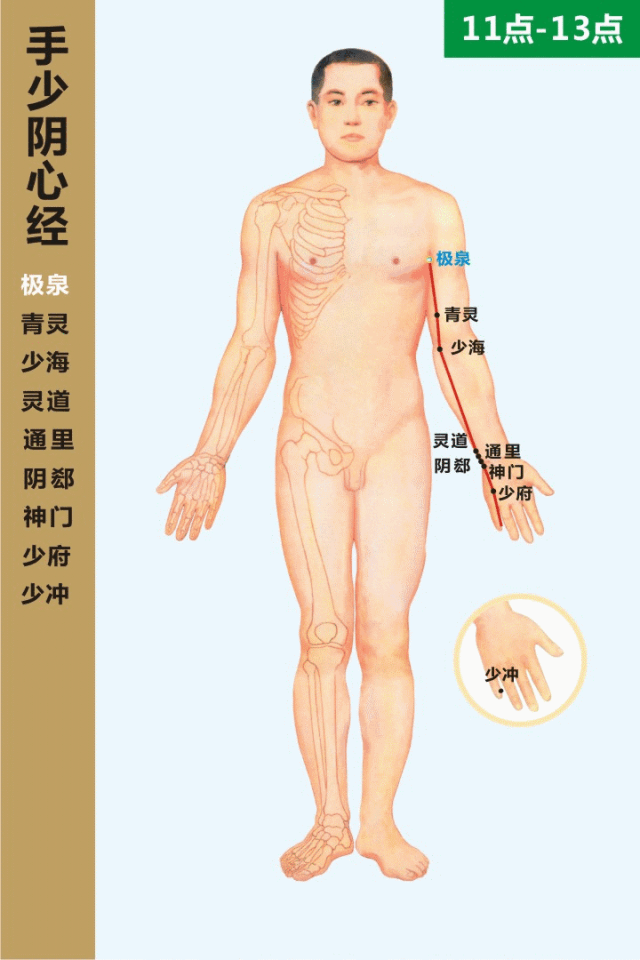 Eliminate the root of all diseases; the heart meridian primarily regulates emotions. Squeeze it 2-3 times a day for 3 minutes each time, and you will feel light and refreshed, preventing sagging flesh. The heart meridian starts at the Jiquan Point under the armpit and ends at the Shaochong Point on the little finger. The heart meridian can treat primary heart diseases and emotional disorders, such as mental confusion, depression, and excessive sweating in the palms.Acupoints on the Heart Meridian:Jiquan Point: Can improve dry throat, irritability, thirst, lymphatic issues, and regulate heart rhythm. The Pericardium Meridian treats cardiovascular diseases, while the Heart Meridian addresses emotional issues.
Eliminate the root of all diseases; the heart meridian primarily regulates emotions. Squeeze it 2-3 times a day for 3 minutes each time, and you will feel light and refreshed, preventing sagging flesh. The heart meridian starts at the Jiquan Point under the armpit and ends at the Shaochong Point on the little finger. The heart meridian can treat primary heart diseases and emotional disorders, such as mental confusion, depression, and excessive sweating in the palms.Acupoints on the Heart Meridian:Jiquan Point: Can improve dry throat, irritability, thirst, lymphatic issues, and regulate heart rhythm. The Pericardium Meridian treats cardiovascular diseases, while the Heart Meridian addresses emotional issues.
8. Small Intestine Meridian
Wei Time: 13:00 – 15:00
Small Intestine Meridian: The small intestine meridian adjusts the body’s nutrition during Wei time. If there is heat in the small intestine, the body will experience gas. Therefore, lunch should be eaten before 1:00 PM to ensure that nutrients are absorbed into the body.
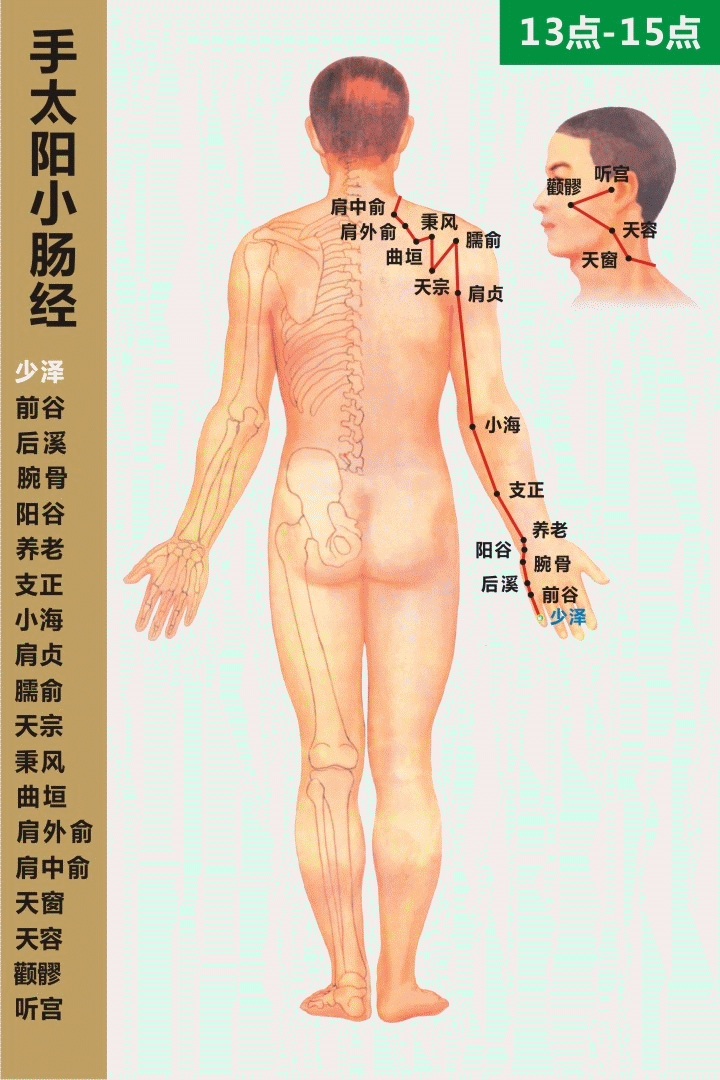 The small intestine governs liquid diseases, and its effects are immediate. The small intestine has a primary function of distinguishing clear from turbid, absorbing nutrients from digested food and excreting waste. The small intestine meridian runs from the Shaoze Point on the little finger to the arm, shoulder, and behind the ear, ending at the Ting Gong Point. There are 19 acupoints along this meridian; massaging the small intestine meridian can improve shoulder, neck, and cervical spine issues and enhance blood supply to the brain. Essential oils such as geranium can be used for massage, addressing all liquid-related diseases, such as menstruation, breast milk, vaginal discharge, semen, and what modern medicine refers to as gastric juice, pancreatic fluid, and prostatic fluid.
The small intestine governs liquid diseases, and its effects are immediate. The small intestine has a primary function of distinguishing clear from turbid, absorbing nutrients from digested food and excreting waste. The small intestine meridian runs from the Shaoze Point on the little finger to the arm, shoulder, and behind the ear, ending at the Ting Gong Point. There are 19 acupoints along this meridian; massaging the small intestine meridian can improve shoulder, neck, and cervical spine issues and enhance blood supply to the brain. Essential oils such as geranium can be used for massage, addressing all liquid-related diseases, such as menstruation, breast milk, vaginal discharge, semen, and what modern medicine refers to as gastric juice, pancreatic fluid, and prostatic fluid.
9. Bladder Meridian
Shen Time: 15:00 – 17:00
Bladder Meridian: Time for urination! The bladder expels water from the body. If there is heat in the bladder, it can lead to bladder cough, which is coughing while urinating. The bladder is most active at this time, so drink plenty of water. Do not hold urine at this time, as it can lead to urinary retention.
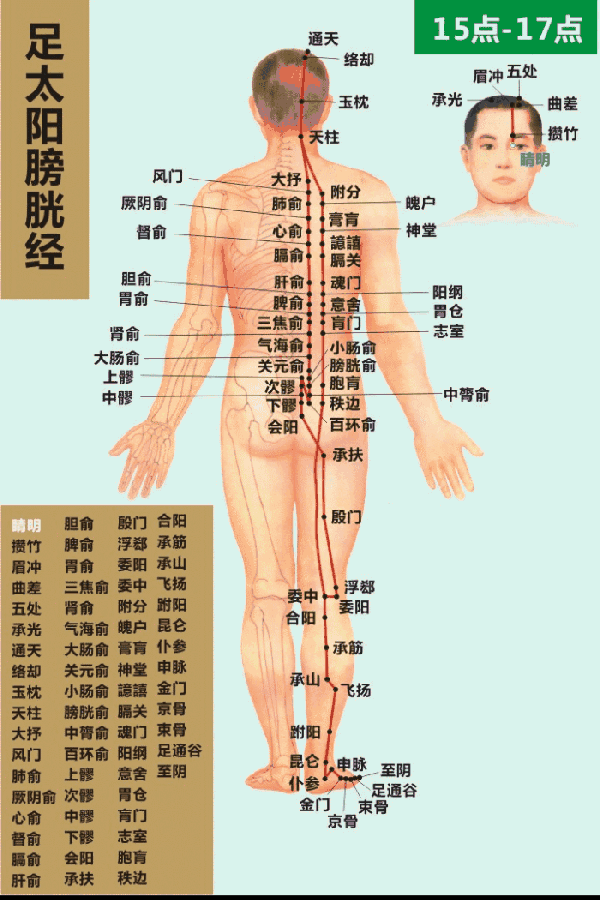 Keep the detox pathways open and unobstructed; it is the most important detox pathway in the body. Maintaining the bladder meridian’s patency is essential for a toxin-free body. If you want to reduce back and buttock fat, massaging and scraping the bladder meridian on the back is very effective.Expelling wind, cold, heat, dampness, dryness, and toxins from the body achieves the effect of unblocking the hundred vessels and eliminating diseases, especially effective for modern sub-health and chronic disease conditioning, targeting muscle soreness, body aches, and swelling.The Three Major Detox Pathways of the Body:First: The ureters expel urine, which is the largest detox pathway in the body.Second: The intestines expel waste from the body; in fact, expelling toxins through urine is more important for the body because a person can survive for ten days without defecating, but three days without urinating can be dangerous.Third: Through the pores, toxins are expelled through sweating.The bladder meridian controls both urine and sweat pathways, so this meridian must not be blocked. Additionally, the bladder meridian directly connects to the organs, starting from the Jingming Point at the eyes to the outer side of the little toe.Acupoints on the Bladder Meridian:Qingming Point: The primary acupoint for treating eye diseases.Cuanzhu Point: Very effective for heat symptoms, such as red and swollen eyes; massaging this point yields immediate results.Small Tips:1. Use the tips of ten fingers to stimulate the bladder meridian on the head 50 times daily to clear the nose, treat eye diseases, headaches, and epilepsy.2. Regularly tapping the back and the back of the thighs can aid in weight loss and expel cold from the body, which is a very good health method.
Keep the detox pathways open and unobstructed; it is the most important detox pathway in the body. Maintaining the bladder meridian’s patency is essential for a toxin-free body. If you want to reduce back and buttock fat, massaging and scraping the bladder meridian on the back is very effective.Expelling wind, cold, heat, dampness, dryness, and toxins from the body achieves the effect of unblocking the hundred vessels and eliminating diseases, especially effective for modern sub-health and chronic disease conditioning, targeting muscle soreness, body aches, and swelling.The Three Major Detox Pathways of the Body:First: The ureters expel urine, which is the largest detox pathway in the body.Second: The intestines expel waste from the body; in fact, expelling toxins through urine is more important for the body because a person can survive for ten days without defecating, but three days without urinating can be dangerous.Third: Through the pores, toxins are expelled through sweating.The bladder meridian controls both urine and sweat pathways, so this meridian must not be blocked. Additionally, the bladder meridian directly connects to the organs, starting from the Jingming Point at the eyes to the outer side of the little toe.Acupoints on the Bladder Meridian:Qingming Point: The primary acupoint for treating eye diseases.Cuanzhu Point: Very effective for heat symptoms, such as red and swollen eyes; massaging this point yields immediate results.Small Tips:1. Use the tips of ten fingers to stimulate the bladder meridian on the head 50 times daily to clear the nose, treat eye diseases, headaches, and epilepsy.2. Regularly tapping the back and the back of the thighs can aid in weight loss and expel cold from the body, which is a very good health method.
10. Kidney Meridian
You Time: 17:00 – 19:00
Kidney Meridian: The kidneys are the essence of reproduction and the essence of the five organs and six bowels. The kidneys are the root of pre-natal essence. After the body’s detoxification during Shen time, the kidneys enter the time for storing essence during You time. This is a crucial time for men. For those with kidney function issues, massaging the kidney meridian at this time is most effective.
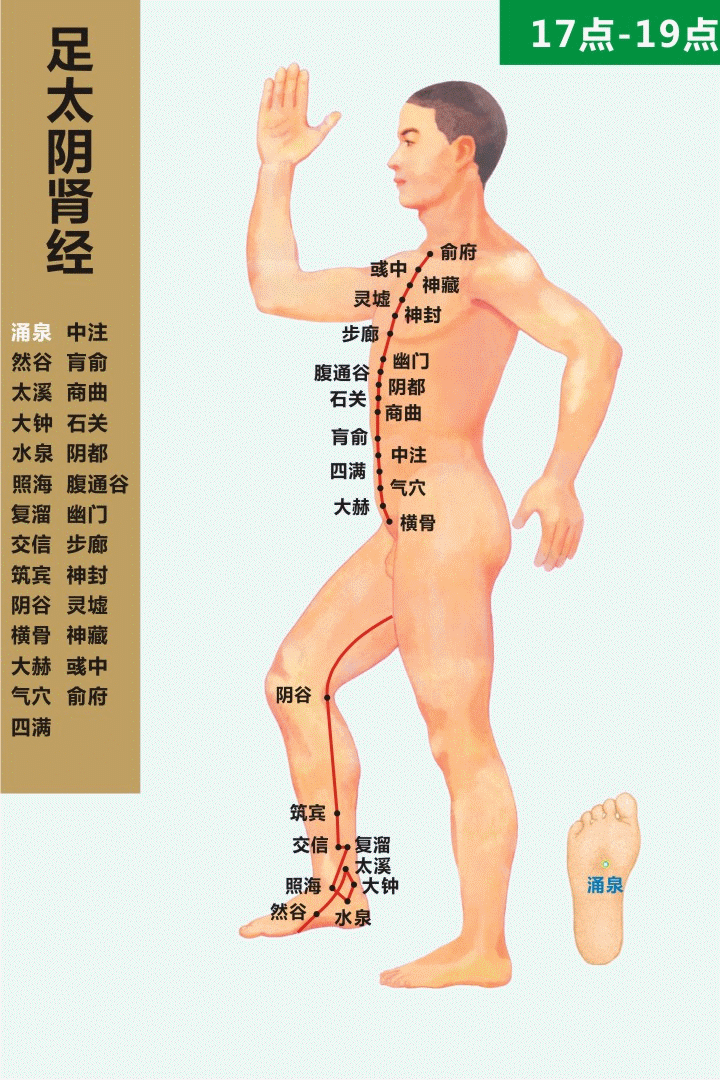 Activate the root of pre-natal essence; fear not disease and aging. The kidney meridian starts from the Yongquan Point and circulates to the head; tonifying the kidneys is a lifelong task. Strong kidney qi prevents aging.Acupoints on the Kidney Meridian:Yongquan Point: Regular stimulation and massage can prevent aging.Rangu Point: Treats diabetes, irritability, dry mouth, nocturnal emissions; if one frequently feels thirsty and anxious, it indicates excessive heart fire; massaging this point can help reduce heart fire.Dazhong Point: Treats loss of voice and heel pain; acupoints on the kidney meridian can also treat throat diseases, as the kidney meridian connects to the throat.
Activate the root of pre-natal essence; fear not disease and aging. The kidney meridian starts from the Yongquan Point and circulates to the head; tonifying the kidneys is a lifelong task. Strong kidney qi prevents aging.Acupoints on the Kidney Meridian:Yongquan Point: Regular stimulation and massage can prevent aging.Rangu Point: Treats diabetes, irritability, dry mouth, nocturnal emissions; if one frequently feels thirsty and anxious, it indicates excessive heart fire; massaging this point can help reduce heart fire.Dazhong Point: Treats loss of voice and heel pain; acupoints on the kidney meridian can also treat throat diseases, as the kidney meridian connects to the throat.
11. Pericardium Meridian
Xu Time: 19:00 – 21:00
Pericardium Meridian: This moment creates conditions for peaceful sleep and a calm mindset.
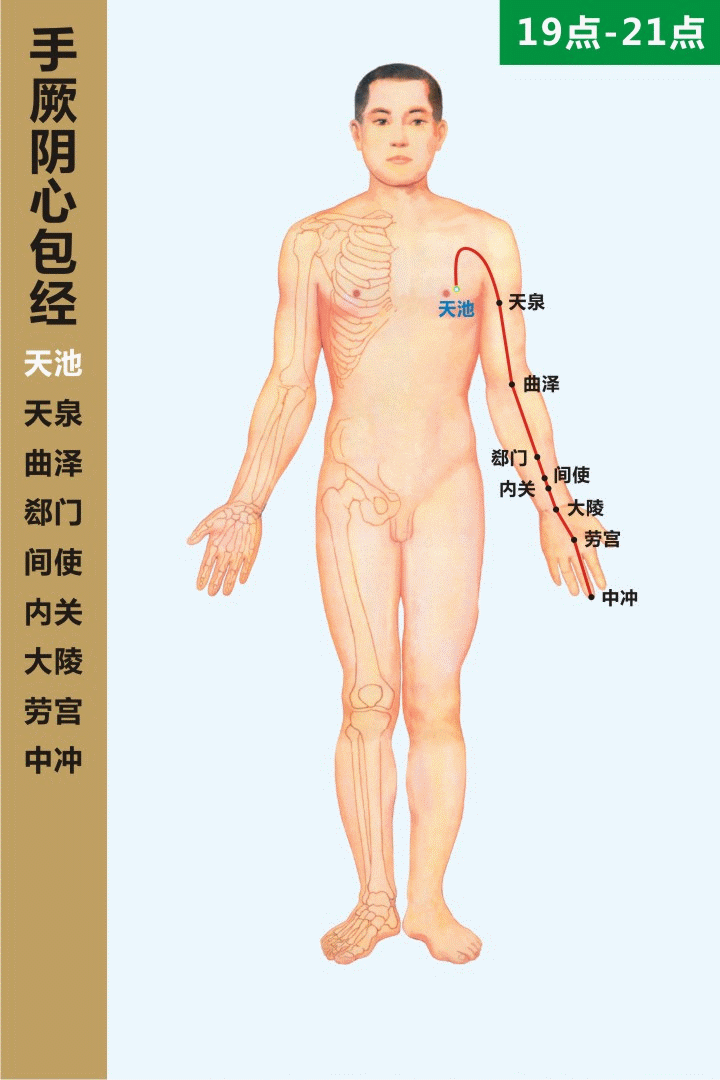 Saving lives, it can regulate heart function and serves as the heart’s protector. Regularly tapping the pericardium meridian is like adding a double layer of insurance for life. The pericardium meridian runs from the center of the breast to the arm.Acupoints on the Pericardium Meridian:Tian Chi Point: Located one inch beside the nipple, treats breast hyperplasia, mastitis, and other breast system diseases and lymphatic tuberculosis.
Saving lives, it can regulate heart function and serves as the heart’s protector. Regularly tapping the pericardium meridian is like adding a double layer of insurance for life. The pericardium meridian runs from the center of the breast to the arm.Acupoints on the Pericardium Meridian:Tian Chi Point: Located one inch beside the nipple, treats breast hyperplasia, mastitis, and other breast system diseases and lymphatic tuberculosis.
12. Sanjiao Meridian
Hai Time: 21:00 – 23:00
Sanjiao Meridian: Time to sleep! This is when the body’s largest organ, the Sanjiao, operates, governing all qi and unblocking water pathways. During Hai time, the Sanjiao connects the hundred vessels. It is a time for rest and recuperation.
 Have you detoxified today? The Hand Shaoyang Sanjiao Meridian is one of the best meridians for detoxification, starting from the Guan Chong Point on the ring finger and ending at the Si Zhu Kong Point on the face, traversing the hand, shoulder, neck, and face. There are 20 acupoints along this meridian.Blockage of the Sanjiao meridian can lead to numbness in the arms, shoulder and neck pain, shoulder periarthritis, throat pain, dry throat, migraines, and wrinkles around the eyes. The circulation time is from 21:00 to 23:00; massaging and tapping during this time can have health benefits. If symptoms of Sanjiao blockage arise, essential oils such as eucalyptus, peppermint, and lavender can enhance the massage effects.13. Governing Vessel
Have you detoxified today? The Hand Shaoyang Sanjiao Meridian is one of the best meridians for detoxification, starting from the Guan Chong Point on the ring finger and ending at the Si Zhu Kong Point on the face, traversing the hand, shoulder, neck, and face. There are 20 acupoints along this meridian.Blockage of the Sanjiao meridian can lead to numbness in the arms, shoulder and neck pain, shoulder periarthritis, throat pain, dry throat, migraines, and wrinkles around the eyes. The circulation time is from 21:00 to 23:00; massaging and tapping during this time can have health benefits. If symptoms of Sanjiao blockage arise, essential oils such as eucalyptus, peppermint, and lavender can enhance the massage effects.13. Governing Vessel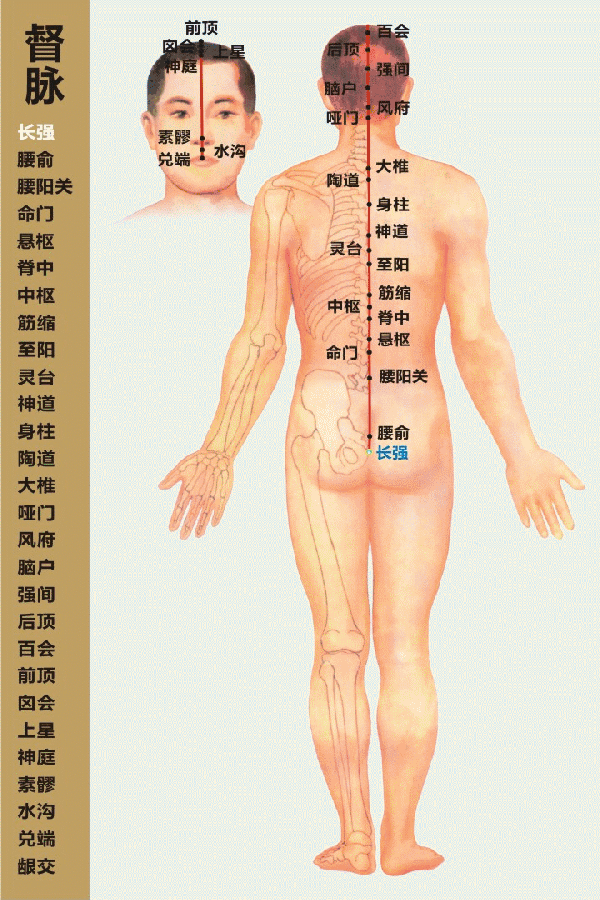 It governs all yang meridians.The place where the sun rises in the body, the governing vessel must be strong to stand tall; acupoints include:Da Zhui Point: Eliminates heat toxins, resists wind and cold; during colds and fevers, do not take medicine; just cupping or scraping this point.14. Conception Vessel
It governs all yang meridians.The place where the sun rises in the body, the governing vessel must be strong to stand tall; acupoints include:Da Zhui Point: Eliminates heat toxins, resists wind and cold; during colds and fevers, do not take medicine; just cupping or scraping this point.14. Conception Vessel Unblocking the conception vessel prevents all toxins; when regulating the conception vessel, pay attention to three points:1. Use moxa to fumigate the navel (Shen Que Point), which has a great tonifying effect.2. Cupping at the Zhong Wan and below the Qi Hai can help regulate the five organs and six bowels, calming the spirit.3. Regularly push the abdomen and massage the Dan Zhong Point.Technique:Using the kneeling method before sleep can accelerate the flow of qi and blood, directing it to the knees. After eating, qi and blood should be concentrated in the stomach; directing it to the knees immediately is not conducive to digestion.Diagnosis through Acupoint Massage:Soreness: The meridian is open, but qi and blood are insufficient; increase qi and blood to alleviate soreness. For example, if someone who rarely climbs mountains feels sore after climbing, it indicates insufficient qi and blood; soreness is a good sign, indicating that the meridian is open but temporarily lacking blood, needing supplementation.Soreness and Pain: Indicates blood deficiency and some stagnation; cupping is the best remedy.Distension: Indicates excess qi, often associated with irritability; if qi cannot be expelled, it leads to distension. Do not cup at this time, as it may worsen the distension.Distension and Pain: Indicates strong fire and irritability, suggesting excess qi but insufficient blood, leading to poor blood distribution.Pain: Indicates blood stasis; cupping is necessary.Summary
Unblocking the conception vessel prevents all toxins; when regulating the conception vessel, pay attention to three points:1. Use moxa to fumigate the navel (Shen Que Point), which has a great tonifying effect.2. Cupping at the Zhong Wan and below the Qi Hai can help regulate the five organs and six bowels, calming the spirit.3. Regularly push the abdomen and massage the Dan Zhong Point.Technique:Using the kneeling method before sleep can accelerate the flow of qi and blood, directing it to the knees. After eating, qi and blood should be concentrated in the stomach; directing it to the knees immediately is not conducive to digestion.Diagnosis through Acupoint Massage:Soreness: The meridian is open, but qi and blood are insufficient; increase qi and blood to alleviate soreness. For example, if someone who rarely climbs mountains feels sore after climbing, it indicates insufficient qi and blood; soreness is a good sign, indicating that the meridian is open but temporarily lacking blood, needing supplementation.Soreness and Pain: Indicates blood deficiency and some stagnation; cupping is the best remedy.Distension: Indicates excess qi, often associated with irritability; if qi cannot be expelled, it leads to distension. Do not cup at this time, as it may worsen the distension.Distension and Pain: Indicates strong fire and irritability, suggesting excess qi but insufficient blood, leading to poor blood distribution.Pain: Indicates blood stasis; cupping is necessary.Summary
The basic spirit and main content of the Huangdi Neijing include: holistic concepts, Yin-Yang and Five Elements, Zangxiang and meridians, etiology, pathogenesis, diagnostic methods and treatment principles, preventive health, and the study of Five Movements and Six Qi.
The “holistic concept” emphasizes that the human body is an integral part of nature, and that the structure and various parts of the body are interconnected.
The “Yin-Yang and Five Elements” theory explains the relationship of opposition and unity between things. The “Zangxiang and meridians” focus on studying the physiological functions, pathological changes, and interrelationships of the five organs, six bowels, twelve meridians, and eight extraordinary vessels. The “etiology and pathogenesis” elucidate the internal mechanisms of disease occurrence and change after various pathogenic factors act on the human body.
The “diagnostic methods and treatment principles” are the fundamental principles of TCM for understanding and treating diseases.
The “preventive health” systematically elaborates on TCM’s theories of health preservation based on time and place, summarizing important experiences in disease prevention.
The “study of qi” examines the impact of natural climate on human physiology and pathology, guiding people to seek benefits and avoid harm.
If you want to view past content👇
Bai Mudan Tea – A Treasure Among Teas
This Chinese patent medicine tonifies the qi of the spleen and stomach, transforming phlegm in the spleen and stomach!
Top Ten Chronic Diseases Treated with Sanqi Powder
Best method to restore immunity: tonify qi!
For hair loss and graying, take two black sesame pills daily; excellent for nourishing hair, tonifying the liver and kidneys, and moistening the five organs!
Heat above, cold below; what are the clever remedies in TCM?
Witness: Examples of Sanqi in treating various conditions

